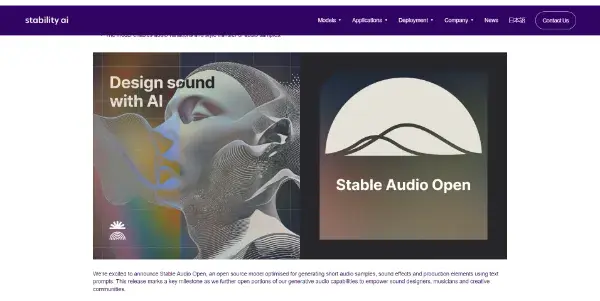Stable Audio Open

Generate audio samples and sound effects up to 47 seconds long from a prompt. This is the open-source version of Stability.ai's famous audio model
Stable Audio Open: A Deep Dive into Open-Source Audio Generation
Stable Audio Open is a groundbreaking, open-source AI tool capable of generating high-quality audio samples and sound effects from simple text prompts. Developed as the open-source counterpart to Stability AI's proprietary audio model, it offers users the power to create audio content up to 47 seconds in length, completely free of charge. This article explores its capabilities, applications, and how it stacks up against similar tools.
What Stable Audio Open Does
At its core, Stable Audio Open translates text descriptions into corresponding audio. You provide a text prompt, detailing the desired soundscape, instruments, or effects, and the model generates an audio file matching your specifications. This allows for rapid prototyping, experimentation, and the creation of unique soundscapes without the need for extensive musical expertise or expensive equipment.
Main Features and Benefits
- Text-to-Audio Generation: The primary feature is its ability to generate audio directly from text prompts. This opens up creative possibilities for individuals with limited musical skills.
- Open-Source Nature: Being open-source, Stable Audio Open allows for community contributions, improvements, and modifications. This fosters transparency and encourages innovation.
- High-Quality Output: While limited to 47 seconds per generation, the audio quality is generally considered high for an open-source model, making it suitable for a variety of applications.
- Free to Use: The tool is completely free, eliminating the barrier to entry for many users. This makes it accessible to both hobbyists and professionals alike.
- Ease of Use: The user interface is designed for accessibility, making it simple to input prompts and generate audio.
Use Cases and Applications
The applications of Stable Audio Open are numerous and diverse:
- Game Development: Creating unique sound effects and background music for indie games.
- Film and Video Production: Generating atmospheric soundscapes and incidental music for short films or videos.
- Music Composition: Serving as a starting point for musical ideas or generating unique sound textures.
- Podcast Production: Creating jingles, sound effects, or background music for podcasts.
- Educational Purposes: Demonstrating the principles of AI-powered audio generation.
- Accessibility: Creating audio descriptions for visually impaired users.
Comparison to Similar Tools
Stable Audio Open competes with other text-to-audio tools, but its open-source nature and free access differentiate it significantly. While proprietary tools often offer longer generation lengths and potentially higher fidelity, they usually come with subscription fees or usage limitations. Stable Audio Open provides a valuable alternative for users seeking a free and accessible option. The trade-off is the shorter generation length and potential limitations in fine-grained control. Further, community development is likely to improve the model over time, reducing the gap with commercial offerings.
Pricing Information
Stable Audio Open is completely free to use. There are no subscription fees, usage limits (beyond the 47-second limit per generation), or hidden costs associated with its use. This makes it a highly attractive option for users on a budget or those exploring the potential of AI-powered audio generation.
Conclusion
Stable Audio Open offers a compelling solution for anyone seeking to generate audio from text prompts. Its open-source nature, free accessibility, and relatively high-quality output make it a valuable tool for a wide range of applications. While limitations exist, particularly regarding the length of generated audio, its potential for improvement through community involvement and its low barrier to entry make it a strong contender in the rapidly evolving field of AI-powered audio generation.